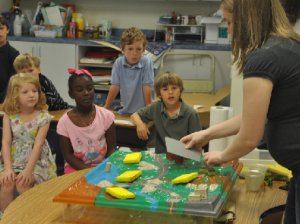My Top 5 Resources for Teaching Geography Skills

One of the hardest challenges that new (and even experienced) teachers face is trying to stay up to date with the vast range of materials and resources that are out there and available for teachers to use in their classroom. How can you make sure that your teaching is relevant and suitable for the students in your class if you don’t have an understanding of what kind of resources are available? How can I make sure I'm preparing students for the future? How can I show them how to use technology effectively.
Fortunately, in my experience, teachers are great sharers. I’ve been working with some pre-service primary school teachers, and as we’ve come to grips with the geography syllabus, they have shared with me a whole range of interesting resources that might help when you teach your students geography skills. And, like a lot of real world geography, technology is at the heart of most of these.
Note: these are for geography skills, and are aimed mostly at primary or middle school students, although with a bit of clever adaptation, they could work for older children too.
Here are my 5 best resources for teaching geography skills:
1. Google Maps
This one is the real game changer for teachers. There is literally so much that can be done using Google Maps - and so few teachers make use of the fantastic possibilities available. You can build tours, you can measure distances, you can look at directions and compare different kinds of maps. The potential is huge. Do yourself a favour and check out the education page to see what can be done and to be inspired: http://maps.google.com/help/maps/education/
The Ordnance Survey website is based in the UK, but it contains some brilliant kid-friendly activities that are sure to encourage students to learn more about geogaraphy. They also have relevance worldwide, not just to the UK. Students can practice map skills, play geography-related games, and use Geographic Information Systems (GIS) to learn more about their world. And it’s all presented in a bright, friendly and colorful way.
3. GeogSpace
This one is a Australian-centric, but again, even if you are not in Australia, it is still worth checking out. Whereas the other two sites I mentioned before are mostly for students to play with, this one is better suited for teachers. There is a wealth of information about fieldwork, using ICT, teaching geography and lots of examples of teachers sharing best practice. Strongly recommended if you are new to teaching geography - it will give you some ideas to make your lessons exciting and fun.
Of course, good geography teaching sometimes means taking an integrated approach to learning - and there is a lot to like about the way that Google Lit Trips combines literature with geography. If you’ve ever read a book and wanted to map out the journey that the protagonists take, then you’re going to love Google Lit Trips. From The Grapes of Wrath to The Odyssey to hundreds more (helpfully broken down into age appropriate sections), students can follow in the footsteps of the people in the stories, looking at the environments and places that they visited.
This one is a little more whimsical than others. Becky Cooper asked 75 New Yorkers to share their memories by marking important places on maps. It is an idea that has captured the imagination of the world - now people are doing it in cities like London and Istanbul. I think that it’s a wonderful example of the way that places can be linked to personal experiences. Buy the book, marvel at the stories, and then get your students to do the same!
Ideas about using these resources came from discussions with my tutorial groups, and also from a lecture given by Kaylene Kritharides about Teaching Geography in the Primary Classroom. I appreciate their generosity in sharing their ideas.